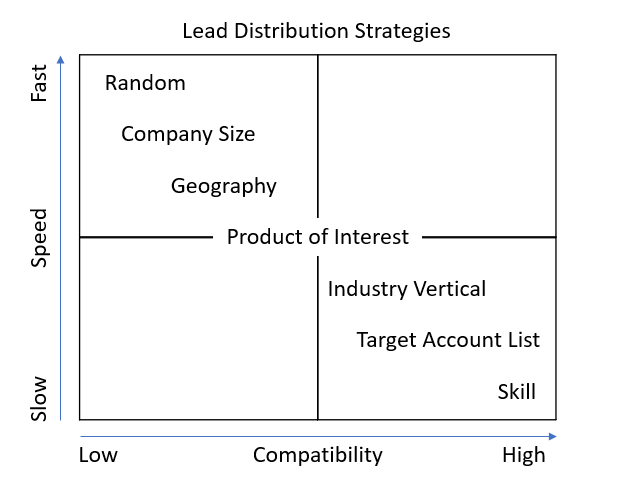Leads are not randomly distributed; the good ones are always given to someone else. So the saying goes.
Inbound lead generation systems often distribute leads equally to lead development teams. These teams often consist of Lead Development Representatives (LDRs), Business Development Representatives (BDRs), and Sales Development Representatives (SDRs). These team members work upper funnel leads before they are passed to Inside Sales Representatives (ISR), Field Sales Representatives (FSRs), and Account Executives (AEs). The team members work down funnel leads after they have been qualified based using methodologies like Budget, Authority, Need, and Timing (commonly referred to by the acronym BANT).
No matter where the leads are worked, it is not uncommon to hear representatives gripping that their leads are terrible and that everyone else’s are better than the ones they received. But are they really?
A common distribution strategy is round robin where everyone gets an equal distribution of inbound leads in the same order until all leads are distributed. Deemed inherently fair since everyone in theory should get the same number of leads, the results should be evenly distributed across the team. We know that isn’t the case since Rep A’s conversion rate is likely to be different that Rep B’s rate. Thus, if everyone is given the same opportunity to receive a lead, there are only two conclusions that can be reached about outcomes: a) it’s the quality of the lead, or b) it’s the quality (aka skill) of the Rep.
Do leads vary in quality? Absolutely they do.
There is a substantial difference between a business-to-business (B2B) lead received from a gmail.com, yahoo.com, hotmail.com or other unbranded email address versus a lead from a branded email address such as Ford.com, GM.com, or Chrysler.com. The former makes intelligent personalization more difficult due to the increased anonymity provided by the unbranded domain. The later makes intelligent personalization easier as the lead is more easily found using tools like LinkedIn Sales Navigator, ZoomInfo and other research resources.
Sometimes simply using Google.com to search for an email address returns a wealth of information that will often include links to company websites, profiles on LinkedIn, and other information where the email address has been indexed by search engines.
Best practices include using matching strategies with new inbound leads to decide if the lead is already known to the company because they are an existing customer or were prospected before which could lead to reduced research time as there may be a complete history of the lead in the company’s Customer Relationship Management system (CRM).
When considering how to distribute leads among the sales team, there are several things to consider: a) the algorithm you’re going to use, b) the speed at desired for first touch, and c) the compatibility with the representative or seller conducting the outreach.
Random Distribution or Complicated Algorithm
Lead distribution strategies have multiplied as lead generation and sales enablement platforms have grown more sophisticated. How leads flows and are divvied up has progressed from simple random distribution tactics to complex strategies that match leads with sellers based on geography, industry vertical, target account list, product of interest, or company size. More recent leads can be distributed based on engagement with company assets and collateral such as web-based demos, downloaded eBooks, white papers, web page visited, or even based on the web page from which the Contact Me lead was generated. Sophistication in measuring marketing effectiveness has improved dramatically wherein every lead can be presented with a unique toll-free number that they can call on thus allowing marketing the opportunity to trace prospects from first contact all the way through to closed sale.
Speed or Compatibility
Speed. The first question to ask is: At what speed should a lead be engaged? As quickly as possible is the most likely answer. Clearly for “contact me” leads, where the lead is asking for engagement, the lead should be followed-up on as quickly as is practical. But other leads where lead scoring is based on visitor engagement with websites, demos, and other assets, the lead should be followed-up at an appropriate pace. What pace? That might be decided based on the engagement. Website engagement may not be enough by itself to call for rapid and immediate follow-up. It could feel a little “big brother” or “we’re watching what you do” – that could come off a creepy or stalking.
Compatibility: The second question to ask is: Who should engage the lead? Once speed is decided, then more complicated algorithms designed to match the lead with the sellers best equipped to work with the lead can be brought to bear and engagement with the prospect.
Evaluation Quadrant
The quadrant diagram (below) illustrates the relative relationship among lead distribution strategies (those mentioned earlier) along two dimensions: Speed and Compatibility. The visualization helps put the distribution strategies into perspective.
A random distribution strategy could result in the fastest initial outreach but with the lowest compatibility with the representative or seller receiving the lead. A skill-based distribution strategy could result in the slowest initial outreach but with the highest compatibility based on ability of the representative or seller receiving the lead.

Another consideration is strategy maintenance. Lead distribution engines required maintenance. For example, if you elect to skill-based distribution and lead routing, then you’ll need to maintain a roster of who has what skills. Those skills could be language skills (Spanish, German, French, etc.) or technical skills (programming language, operating system, application use, etc.). When representatives or seller leave the company, the roster would need to be updated based on the skills compatibility of those representatives that still in role. The matrix of sellers to skill category can be complex, multi-dimensional and exceedingly difficult to support.
No matter the distribution strategy along the speed and compatibility continuum, the experience, training, and skill of the sales team members shouldn’t be overlooked. There can be a marked difference in the results achieved when comparing newbies to veteran sales representatives. High turnover among sales teams can lead to poor sales performance simply because they just have ramped in skill. New team members simply may not be able to deliver the company’s value proposition while identifying compelling events where the company’s product can solve the customer’s problems. They just will not be able to position and sell the solution as well as veterans on the sale team. But veteran’s can be predisposed and biased based on prior experiences with prospects and customer to prematurely reject leads as un-sellable even though they are not.
Smart Lead Distribution Using Long Short-term Memory Recurrent Neural Network
Smart lead distribution endeavors to get the right lead to the right representative at the right time. It can be a game changer if it incorporates flexible automation on how leads are distributed or claimed by incorporating concepts that include first-to-claim, round robin, territory, vertical, product of interest, etc. It should also include the level of seller activity (how busy), who owns the account, and who last touched the lead. Smarter lead distribution might even go as far as to reclaim stale leads for redistribution. And the smartest lead distribution systems might profile the lead and match the lead to sellers based on prior success with similar leads.
Deep learning has led to tremendous advancement in the field of artificial intelligence. There is the potential to apply recurrent neural networks to the problem of identifying, constructing, and supporting smarter lead distribution algorithms while implementing nuanced rule sets. Unlike standard feedforward neural networks, Long Short-term Memory (LSTM) recurrent neural networks (RNN) have feedback connections. And as such, a LSTM recurrent neural network can process not just single data points but entire sequences of data. This is ideal when it comes to finding buying signals from leads throughout the buying cycle, thus enabling the possibility of earlier and earlier engagement with the lead by the most appropriate representative or seller at just the right time with just the right message. That is to say, the right lead routed at the right time to person for the right for sales motion.
The potential to use LSTM recurrent neural networks for optimized lead distribution is tremendous. A large historical sample of data is likely required to build a robust model for effective distribution. Collecting outcomes will be essential to building the model. A robust model might even recommend the ideal sales motion based on learning what has worked in the past to convert leads into closed sales.
In the illustration (below) the hidden layer is the resulting distribution model expressed as neural network. The input layers could be observations such as company size, location, product of interest, industry vertical, targeted. Inputs could also include data about seller activity, number of leads in pipeline, sales cycle time, and the like. The output layers might result in distributing leads using a round-robin mechanism across LDRs, SDRs, BDRs, drop them into one or more queues for shark tank, blind pulls or cherry picking, or perhaps assigned leads directly to top producers based on past performance with those types of leads.
A large historical sample of data is likely required to build a robust model for effective distribution and lead handling. Collecting outcomes will be essential to building the model. As will knowing what sales motions (calls, emails, social, other) were applied to the lead. The possibilities are not limitless but recurrent neural networks introduce a whole new level of disruptive thinking into the way in which leads could distributed among the members of selling team.

Lead Distribution Should Not Be Left to a Random Roll of the Dice
No matter how you think about it, lead distribution should not be left to a random roll of the dice. The potential to use LSTM recurrent neural networks for optimized lead distribution and handling has immense potential. With a data backed recurrent neural network tuned with seller performance and outcomes could be a game changer ensuring that leads are not randomly distributed but the good ones are always given to right person at the right time.
About the Author
Stephen Howell is a multifaceted expert with a wealth of experience in technology, business management, and development. He is the innovative mind behind the cutting-edge AI powered Kognetiks Chatbot for WordPress plugin. Utilizing the robust capabilities of OpenAI's API, this conversational chatbot can dramatically enhance your website's user engagement. Visit Kognetiks Chatbot for WordPress to explore how to elevate your visitors' experience, and stay connected with his latest advancements and offerings in the WordPress community.





